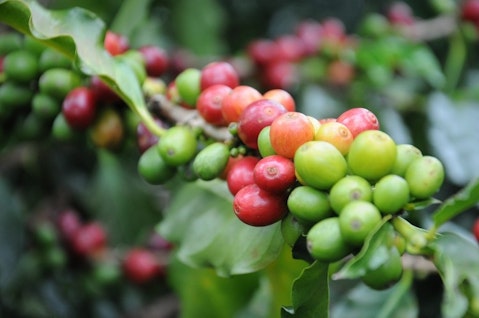Each person in the top 15 caffeine addicted countries with the highest coffee consumption in the world consumes on average between 5.5 kg and 12 kg of coffee. Even though coffee is not the most popular drink in the world and comes fourth after water, milk, and tea, the coffee consumption is still pretty substantial as global coffee export industry is valued at around $20 billion and 90% of it is produced in developing countries in South America, Central America, Asia, and Africa, where it is an important part of the economy.
Every year, people around the globe drink over 500 billion cups of coffee and coffee farms provide livelihood for more than 25 million people. In this way, coffee is the most sought-after commodity in the world after oil and its global value is estimated at around $100 billion. In this way, coffee is also one of the most traded agricultural commodities and coffee futures contracts are trading on New York Mercantile Exchange, New York Intercontinental Exchange, and the London International Financial Futures and Bond Exchange.
Coffee consumption has been on the rise in the last couple of years. According to International Coffee Organization (ICO), the consumption in 2015/2016 amounted to 155.47 million 60-kg bags, this is up from 151.76 million bags in 2014/2015 and more than 146.96 million bags in 2012/2013. Overall between 2012/2013 and 2015/2016, coffee consumption registered an annual growth rate of 1.9%. The bulk of this growth came from Asia and Oceania, where the growth rate amounted to 4.5% helped by higher middle-class income. Europe, where most of the top 15 caffeine addicted countries with the highest coffee consumption in the world are, had a growth rate of 1.0%, behind North America, where the coffee consumption growth rate amounted to 2.6% (see what are the top 10 coffee brands in America).

Pixabay/Public Domain
Because of the consumption growth, the coffee market has experienced a deficit lately, as consumption exceeded production. According to ICO, the deficit in the coffee market is now in its third consecutive year as consumption is expected to exceed production by 1.2 million bags. In 2016/2017, coffee production is estimated at 153.87 million bags, an increase of 1.5% on the year. The increase comes on the back of Arabica coffee production, which jumped by 10.2%, but is offset by the 10.6% drop in production of Robusta. The growth in Arabica production is seen due to Brazil ramping up production after a couple of years of draught and Colombia, which growths only Arabica, maintaining high production volumes for several years in a row. On the other hand, adverse weather in Indonesia and Vietnam led to a drop in production of Robusta, which grows mostly in the Eastern Hemisphere.
Arabica and Robusta are the main types of coffee, the main difference being that Arabica beans are of a higher quality and more expensive, while Robusta coffee is stronger, easier to grow and cheaper. However, there are some types of Robusta coffee that are of high quality and very appreciated for their deep flavor. We have compiled a list of 10 best tasting highest rated coffee beans in the world.
Suggested article: Top 20 Coffee Brands In The World
With this in mind, let’s take a look at the top 15 caffeine addicted countries with the highest coffee consumption in the world, according to ICO, which are the principal markets for coffee producers.
15. Brazil
Consumption of coffee (kg per capita per year): 5.5
The list of top 15 caffeine addicted countries with the highest coffee consumption in the world starts with Brazil. Even though Brazilian culture is often associated with coffee, it’s by far not the world’s largest consumer of the beverage. However, Brazil is one of the world’s largest producers of coffee, mostly Arabica varieties. In 2o16/2017, Brazil is expected to produce 55 million bags of coffee, up by 9.2% on the year. Brazil has been growing coffee since 1727 and at the beginning of the 20th century it was the largest exporter, amassing around 70% of the world’s exports. Coffee export still represents a major part of Brazil’s economy as it accounts for nearly 3% of the country’s exports.

Pixabay/Public Domain
14. Slovenia
Consumption of coffee (kg per capita per year): 5.8
In Slovenia, the coffee culture is very widespread with cafes present all around. For most Slovenians, a cup of strong Turkish coffee is the way to go, with other popular varieties of the beverage including coffee with milk or whipped cream. Turkish coffee in Slovenia is made using a special process when finely ground coffee is immersed in a pot with very hot water (original Turkish coffee involves adding the coffee to cold water) and when it comes to a boil the pot is removed from the burner and the same process is repeated a couple of times before the coffee is served.

Pixabay/Public Domain
13. Italy
Consumption of coffee (kg per capita per year): 5.8
Coffee in Italy has been introduced in the 16th century and the country has developed a very rich coffee culture full of rituals, which are very important for locals. Italians usually have a cappuccine with breakfast, a caffemachiato in the afternoon and an espresso after dinner. Most websites for people who intend to visit Italy warn about respecting these rituals, or risk having Italians raise their eyebrows at you if you order a cappuccino after the morning has passed. Italy imports its coffee and is known for its great coffee companies like Lavazza and Illy.

PHOTOCREO Michal Bednarek/Shutterstock.com
12. Austria
Consumption of coffee (kg per capita per year): 5.9
In Austria, coffee gained popularity in the 16th century. The first coffeehouse in the country was opened in 1683 in Vienna, by a Polish military officer Jerzy Franciszek Kulczycki, who used the coffee beans captured from the defeated Turkish army in the Battle of Vienna. The most popular coffee beverage in the country is Melange, which is mixed with hot foamed milk and comes with a glass of water.

Alex Poison/Shutterstock.com
11. Bosnia and Herzegovina
Consumption of coffee (kg per capita per year): 6.1
Several centuries under the Otoman rule left Bosnia and Herzegovina with many elements of the Turkish culture, including coffee. The most common coffee drink is a local variety of Turkish coffee. The difference between Bosnian and Turkish coffee is in the process. Bosnian coffee involves bringing water close to boiling, setting aside a small amount of water before adding the finely ground coffee. The water is added after the coffee in the pot is boiling, which creates a stronger and more intense flavor.

Daria Minaeva/Shutterstock.com
10. Canada
Consumption of coffee (kg per capita per year): 6.2
Next in line among caffeine addicted countries with the highest coffee consumption in the world is Canada, which not only consumes large amount of coffee beans, but also is one of the largest consumer of the coffee beverage, with an average of 152 liters per person each year. One of the main factors that determine Canadians’ taste for coffee is cold weather, which makes the locals crave a hot pick-me-up in the morning. In addition, the wide availability of quick service restaurants, particularly Tim Hortons helps spread the popularity of coffee in Canada.

Niloo/Shutterstock.com
9. Luxembourg
Consumption of coffee (kg per capita per year): 6.5
For a small country, Luxembourg does seem to be consuming a lot of coffee, however, its location in the middle of Europe means that there are people from the neighboring countries like Germany and Belgium who work in Luxembourg or do their shopping there, buying coffee to sustain themselves during the day or to take it home as coffee prices in Luxembourg are lower due to a low VAT rate.

Marcin Krzyzak/Shutterstock.com
8. Belgium
Consumption of coffee (kg per capita per year): 6.8
Coffee appeared in Belgium and other mainland European countries from Venice, where merchants brought it from Muslims in North Africa. In the last couple of years, as the income of Belgian households went up, the demand for high quality coffee has increased as well. Belgian coffee market is currently dominated by Douwe Egberts, which has a market share of over 30%.

f9photos/Shutterstock.com
7. Switzerland
Consumption of coffee (kg per capita per year): 7.9
Coffee consumption in Switzerland is dominated by fresh ground coffee pods, according to Euromonitor International. Consumers are attracted to these products due to their convenience and the sales of pods surged in the last couple of years. Nestle Suisse is the leading company on the coffee market in Switzerland with a share of 38%, with its Nespresso and Nescafe Dolce Gusto brands amassing 68% of the coffee pods sales in the country.

Copyright: chayathonwong2000 / 123RF Stock Photo
6. Sweden
Consumption of coffee (kg per capita per year): 8.2
On the sixth spot in the list of top 15 caffeine addicted countries with the highest coffee consumption in the world is Sweden. In Sweden, the most popular coffee beverage is drip coffee that is consumed with or without milk, but lattes and cappuccinos have been catching up. Sweden has a special time of the day, called fika, reserved for drinking coffee, usually with a sweet pastry. Swedish coffee market is dominated by Jacobs Douwe Egberts SE and Nestlé Sverige, both subsidiaries of large multinational corporations, which together amassing over a half of the volume sales in the country.

Pixabay/Public Domain
5. Netherlands
Consumption of coffee (kg per capita per year): 8.4
People in Netherlands prefer drip coffee and more people have been switching to high-quality coffee as well as coffee pods. Douwe Egberts Nederland BV, a subsidiary of Douwe Egberts, has the largest market share on the coffee market in Netherlands. However, while Douwe Egberts has a strong presence in ground coffee and soft pods (wrapped in filter paper), its market share might decline as consumers switch to hard pods and to more exclusive coffee brands.

Copyright: jenifoto / 123RF Stock Photo
4. Denmark
Consumption of coffee (kg per capita per year): 8.7
In Denmark, drinking coffee is often a social activity, which is one of the reasons why Danes prefer large coffees, such as lattes that can be drunk longer, therefore allowing consumers to immerse in conversations. At home, Danes prefer fresh ground coffee pods as they have busy lifestyles and often choose convenience above other factors.

Pixabay/Public Domain
3. Iceland
Consumption of coffee (kg per capita per year): 9
Even though there are just 320,000 people in Iceland, they tend to drink a lot of coffee. Coffee in the small island nation, located far from continental Europe and even further from places where coffee is grown, has been consumed since the late 18th century and many Icelanders are compulsive coffee drinkers, spending the entire day with a cup of the beverage by their side.

Pixabay/Public Domain
2. Norway
Consumption of coffee (kg per capita per year): 9.9
Given that its on the second spot among top 15 caffeine addicted countries with the highest coffee consumption in the world, it’s not surprising that Norway has its own coffee culture. Norwegians prefer light roasted coffee of single origin, which emphasizes fruity flavors that are unnoticed in darker roasts. Norwegians started drinking coffee in the 1800s, when they began importing it from America in exchange for fish. As the country went through a period of prohibition and still has high taxes on alcohol, coffee has become the preferred social drink among Norwegians.

Pixabay/Public Domain
1. Finland
Consumption of coffee (kg per capita per year): 12
It may be surprising to discover that Finland comes at the top among caffeine addicted countries with the highest coffee consumption in the world, but Finns do drink a lot of coffee and have been doing it for years. Similar to their Scandinavian neighbors mentioned on the previous page, Finns prefer light-roasted coffee. The Finnish coffee market is led by Gustav Paulig, which has a market share of around 49%.

Veronika Galkina/Shutterstock.com
These are the top 15 caffeine addicted countries with the highest coffee consumption in the world. Most of the countries that came at the top are Scandinavian and are usually marked by cold weather, so coffee for people living there is the hot beverage that allows them to sustain themselves.





